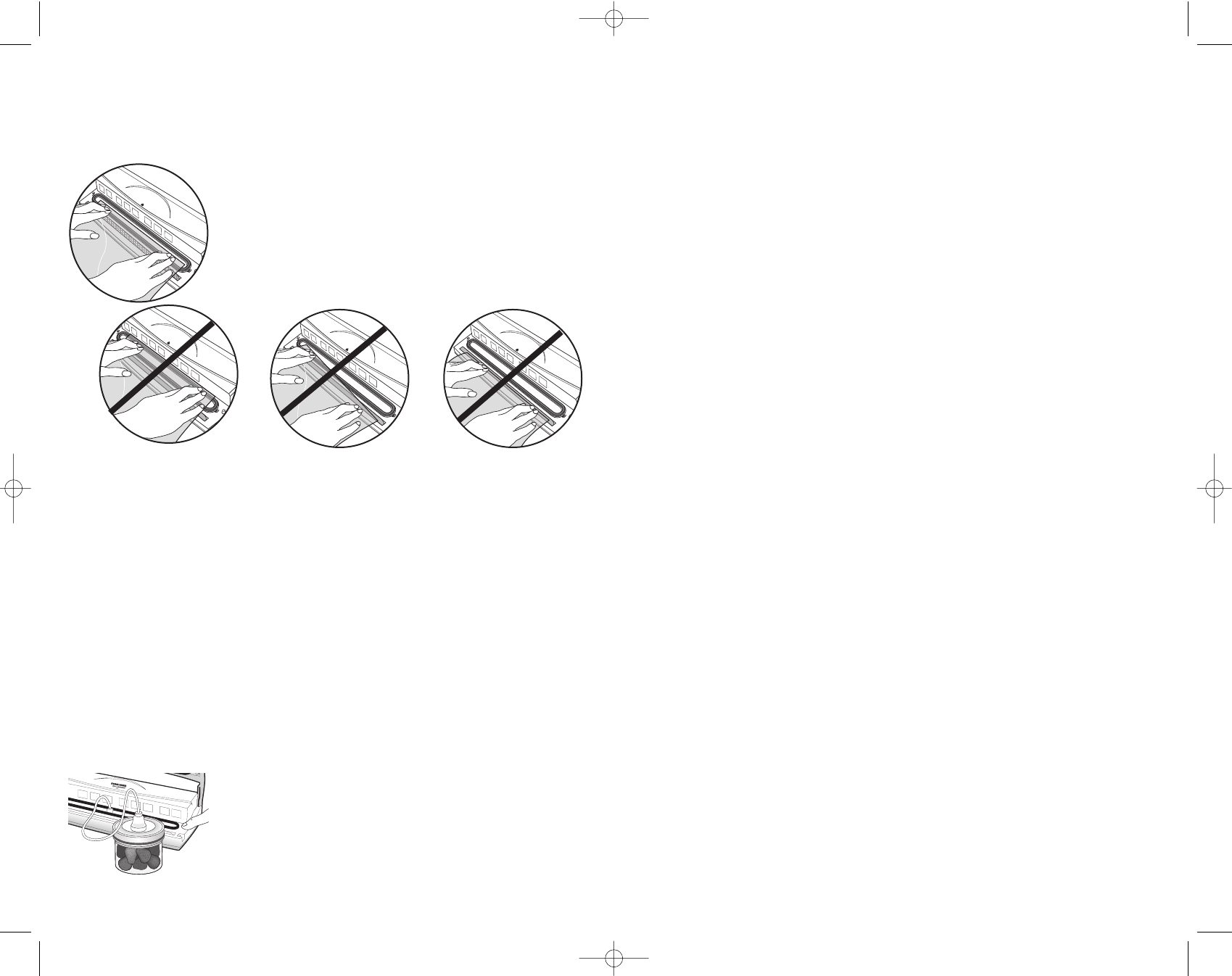
6
5
How to use the FreshGUARD™ Professional-Performance Vacuum Sealer
to vacuum seal:
1. Plug unit and lift lid.
2. Place food or other item in the bag. Do not try to seal fragile foods (breads,
chips, etc.) in vacuum-sealed bag. They will be crushed.
3. For proper vacuuming, place the entire open end of the
bag over the vacuum channel between the black foam
gasket as shown in the upper picture (E). If the bag is
placed as noted in the three lower pictures the unit will
not vacuum the bag.
4. Close the lid. The push bar on the lid pushes down the open end of the bag
into position (see A).
5. Press down the top of the lid at the ends then press in the side latches until you
hear them click into place (see B). The vacuum sealing process begins
automatically. The progress indicator light starts blinking; the unit makes a
deep humming sound.
6. When vacuum sealing process is complete, the sound stops and the light goes
from blinking green to red and then back to green. Press the release button
(see C).
7. Press down the lid at the ends to release the locking latches (see D).
8. Lift the lid and remove the sealed bag. Let the unit rest at least 20 seconds
before using it again.
9. Unplug unit.
How to use the FreshGUARD™ Professional-Performance Vacuum System
canisters to vacuum seal:
1. Place food in canister, then place lid on canister.
2. Plug unit and lift lid.
3. Attach the small end of the hose to the canister
hose port (F).
4. Press and hold the canister vacuum button for about
2 seconds, until the unit starts.
5. After the unit has started, place the large end of the hose
over the vacuum port in the center of the lid.
6. The unit will automatically shut off when canister is vacuum sealed.
7. Detach the hose from the canister and unit.
8. Close unit lid.
9. Unplug unit.
Care and Cleaning
Cleaning the Vacuum Chamber
Caution: Do not clean the vacuum chamber after every use. It is recommended
to clean it every 30 cycles and only if liquids get inside the chamber.
Important: If you see any food particles in the chamber, clean the chamber
to prevent food from getting into pump.
1. Plug unit.
2. Using a measuring cup, fill with 2 tablespoons of water ONLY.
3. Turn on by pressing the canister button.
4. Once unit shuts off, remove drain cup, clean it and insert back into the unit.
5. Unplug unit.
Food Preparation Before Vacuum Sealing
AWord About Food Safety
It is very important that you know and observe some basic safe-food handling
practices as you vacuum seal food:
Keep food, especially meats, fish and poultry refrigerated until ready to vacuum
seal. Store vacuum-sealed meats, fish and poultry in the freezer immediately after
sealing.
Wash hands with warmest water possible and soap and dry with a clean towel
or paper toweling before handling food.
Re-wash hands as above after handling raw meat, fish or poultry and before
handling any other food.
Before re-using a bag in which food was sealed, wash in warmest sudsy water,
rinse thoroughly and allow to thoroughly air dry.
Do not re-use a bag in which raw meat, fish or poultry had been sealed.
To safely thaw food, take from freezer and place directly in refrigerator to thaw,
or defrost in a microwave oven.
Since oxygen (air) and time are the major reasons foods spoil, it is important to
note that vacuum sealing food cannot reverse food deterioration. Food that is not
fresh when you vacuum seal it, will not be any fresher when you un-seal it.
The fresher the food is when you vacuum seal it, the fresher and more flavorful it
will be when it is un-sealed.
While vacuum sealing extends the life of foods, it is not a substitute for canning.
Follow the guidelines in this manual for sealing and storing different types
of foods.
F
E
VS250.Pub1000001093 7/16/04 2:00 PM Page 6


















